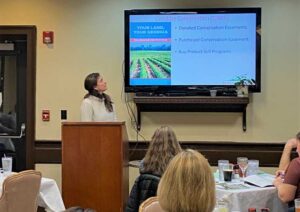Subscribe to Updates
Get the latest agriculture news and updates directly to your inbox.
Author: staff
Most herbicides are formulated with some form of residual activity, extending the life of their weed control. But when herbicides persist in the soil too long, they can cause problems for the following year’s crop. “We want residual control, in some of our herbicides, to control our weeds for three to five weeks,” said Wesley Everman, an Iowa State University Extension weed specialist. “We usually don’t want [control] to last beyond a couple [of] months. It really becomes an issue if it persists for 10 or more months because then, we’re impacting next year’s crop, and its growth, and potentially…
1. Soybean Futures Drop in Overnight Trading Soybean futures plunged in overnight trading after China reportedly bought soybeans from Brazil, the world’s largest exporter of the oilseeds. Buyers purchased 10 cargoes of soybeans from the South American country, Reuters reported, citing three traders familiar with the transaction. The U.S. and China agreed last week to a deal under which the Asian nation would buy at least 12 million metric tons of U.S. soybeans in the last two months of 2025 and a minimum of 25 million tons of soybeans in each of the following three years. Still, Brazilian soybeans are…
U.S. farmer sentiment edged higher in October, buoyed by strength in the livestock sector, according to the Purdue University-CME Group Ag Economy Barometer. The index rose three points to 129, though it remains 29 points below its May peak. The Index of Current Conditions climbed eight points to 130, while the Index of Future Expectations increased just one point to 129. “The fact that those two indexes are essentially the same tells me that farmers expect the tight net return scenario we’re in now to persist,” said Dr. Michael Langemeier, professor of agricultural economics at Purdue University. “Livestock producers are…
By Michael Langemeier, James Mintert, and Joana Colussi When thinking about the adoption of conservation practices, like cover crops, it is important to note two things. First, adoption rates have ebbs and flows; in other words, adoption does not necessarily follow a steady trend. Second, sometimes conservation practices are disadopted, which may happen due to the termination of incentive payments and/or lack of profitability. This article examines trends in the adoption of cover crops, cover crop experience, and percentage of acres planted to cover crops using data from the September Purdue University-CME Group Ag Economy Barometer (AEB) surveys for the last five years. The AEB…
Rep. Harriet Hageman, R-Wyo., and Rep. Ro Khanna, D-Calif., have reintroduced the Country of Origin Labeling Enforcement Act, which would reinstate mandatory country-of-origin labeling (MCOOL) for beef. “American consumers deserve accurate information on the products they buy, and U.S. ranchers deserve honest and fair competition in the marketplace. The U.S. abandoned MCOOL for beef in 2016 following a World Trade Organization ruling. This change lifted the profit margins of monopolistic big packers at the expense of the American rancher. The domestic market is finally providing the means for our producers to keep family ranches alive, and we must protect these…
Milk futures prices have struggled for the past year, as increased production has kept steady pressure on product values. Herd expansion, efficiency, increased revenue from breeding for beef calves, and technical selling have all played a part in weaker prices. World global dairy trade prices have slid as well. The dairy processing industry is expanding, with some estimates as high as $10 billion dedicated toward either revamping or building new processing plants. If demand increases, can the dairy herd respond in a timely fashion to meet demand? Or will a limited supply of dairy heifers and cows help push milk…
By Ryan Hanrahan Politico’s Grace Yarrow and Meredith Lee Hill reported late last week that “the Trump administration plans to roll out an initial payment of up to $12 billion for farmers hurt by the president’s tariff policies once the government shutdown ends, according to three people familiar with the matter. The finalized amount will come on top of President Donald Trump’s recently announced truce with China, which could also give some relief to U.S. producers of soybeans, sorghum and meat.” “Sen. John Hoeven, R-N.D., told reporters Thursday that a Market Facilitation Program — similar to the $28 billion farmer…
Voting is now open to select the winner of the 13th annual National Anthem Contest. Four finalists have been selected, and the National Cattlemen’s Beef Association is inviting the public to vote through Nov. 15. The winner will perform the Star-Spangled Banner at the Opening General Session of CattleCon 2026 in Nashville, Tennessee, Feb. 3 to 5, and will receive round trip airfare, a hotel room for three nights, complimentary convention registration, plus a pair of boots, jeans, and a shirt from Roper or Stetson. Introducing the four finalists: Elle Glaser of Tangent, Oregon, is a fourth-generation farmer who grew…
Just after 9:00 a.m. CT, December corn was down 4¢ at $4.30¼ per bushel. January soybeans were down 15¢ at $11.19¼ per bushel. “Corn, soybeans, and wheat are seeing profit taking this morning following [Monday’s] strong finish,” said Karl Setzer, partner with Consus Ag Consulting. “News that China is booking Brazil soybeans along with U.S. soybeans is removing some of the bullish sentiment following last week’s market run up following the U.S./China trade agreement. A simple correction from [Monday’s] rally is also weighing on the soy complex, as is the end of meals run of 14 consecutive higher closes that…
Most farmers in Iowa are finished with corn and soybean harvest or have just a handful of acres left in the field, according to average harvest rates. Exact data is not available due to the ongoing government shutdown, which paused crop progress and condition reports from the U.S. Department of Agriculture. At this point in the season last year, corn harvest was 92% which was nearly a week ahead of the 2023 harvest and two weeks ahead of the five-year average. Soybeans were 98% complete this time last year. Iowa Secretary of Agriculture Mike Naig said farmers have typically harvested…







:max_bytes(150000):strip_icc()/FomesafenfieldviewZimmerPurdue-f4384b810213434b973ed4ad75f83672.jpeg)
:max_bytes(150000):strip_icc()/Updated3BigThings-3-soybean-harvest-yellow-1-13b4e68e77bc41d8bd69b3b910ff5300.jpeg)

:max_bytes(150000):strip_icc()/cerealryecovercropsUSDA-b131fd0b2c584da7a22485faa6f182c6.jpg)
:max_bytes(150000):strip_icc()/100441307_dairy_cow-2b8693c4806c45a1aa0e89b45bf0ab00.jpg)
:max_bytes(150000):strip_icc()/WhiteHouse-2000-251df9c5b90d4c7da5a9226a5c8f9dac.jpg)

:max_bytes(150000):strip_icc()/Markets-5-Soybeans-dramatic-down-15-1dd1e8e5bab14a3b8e66f834c3b43908.jpeg)
